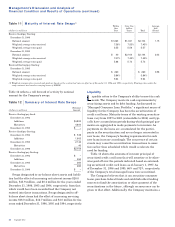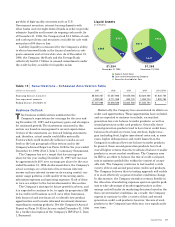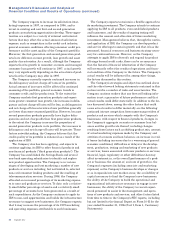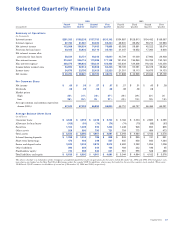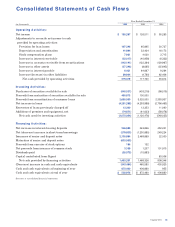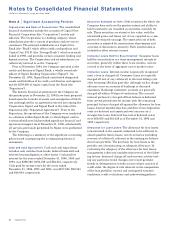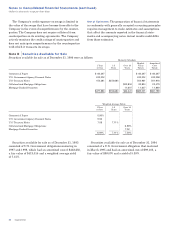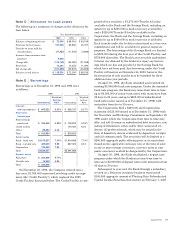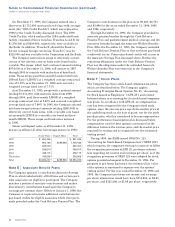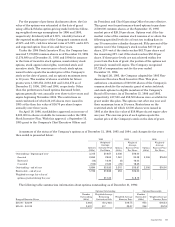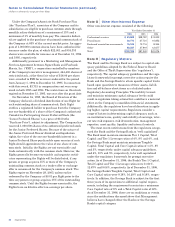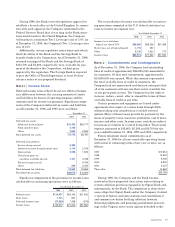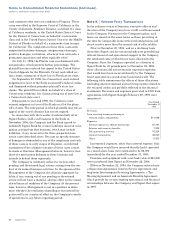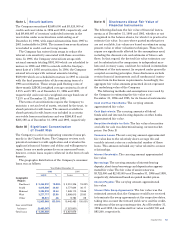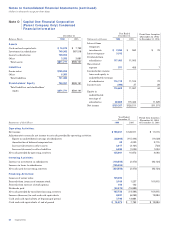Capital One 1996 Annual Report Download - page 46
Download and view the complete annual report
Please find page 46 of the 1996 Capital One annual report below. You can navigate through the pages in the report by either clicking on the pages listed below, or by using the keyword search tool below to find specific information within the annual report.
44 Capital One
Notes to Consolidated Financial Statements
(dollars in thousands, except per share data)
Securities Available for Sale: Debt securities for which the
Company does not have the positive intent and ability to
hold to maturity are classified as securities available for
sale. These securities are stated at fair value, with the
unrealized gains and losses, net of tax, reported as a com-
ponent of retained earnings. The amortized cost of debt
securities is adjusted for amortization of premiums and
accretion of discounts to maturity. Such amortization is
included in other interest income.
Consumer Loans Held for Securitization: Consumer loans
held for securitization are loans management intends to
securitize, generally within three to six months, and are
carried at the lower of aggregate cost or market value.
Consumer Loans: Interest income is generally recognized
until a loan is charged off. Consumer loans are typically
charged off (net of any collateral) in the next billing cycle
after becoming 180 days past-due, although earlier charge-
offs may occur on accounts of bankrupt or deceased
customers. Bankrupt customers’ accounts are generally
charged off within 30 days of verification. The accrued
interest portion of a charged off loan balance is deducted
from current period interest income with the remaining
principal balance charged off against the allowance for loan
losses. Annual membership fees and direct loan origination
costs are deferred and amortized over one year on a
straight-line basis. Deferred fees (net of deferred costs)
were $58,059 and $33,438 as of December 31, 1996 and
1995, respectively.
Allow ance for Loan Losses: The allowance for loan losses
is maintained at the amount estimated to be sufficient to
absorb possible future losses, net of recoveries (including
recovery of collateral), inherent in the existing on-balance
sheet loan portfolio. The provision for loan losses is the
periodic cost of maintaining an adequate allowance. In
evaluating the adequacy of the allowance for loan losses,
management takes into consideration several of the follow-
ing factors: historical charge-off and recovery activity (not-
ing any particular trend changes over recent periods);
trends in delinquencies; trends in loan volume and size of
credit risks; the degree of risk inherent in the composition
of the loan portfolio; current and anticipated economic
conditions; credit evaluations and underwriting policies.
Note A Significant Accounting Policies
Organization and Basis of Presentation: The consolidated
financial statements include the accounts of Capital One
Financial Corporation (the “Corporation”) and its sub-
sidiaries. The Corporation is a holding company whose
subsidiaries provide a variety of products and services to
consumers. The principal subsidiaries are Capital One
Bank (the “Bank”) which offers credit card products and
Capital One, F.S.B. (the “Savings Bank”), which was estab-
lished in 1996, and provides certain consumer lending and
deposit services. The Corporation and its subsidiaries are
collectively referred to as the “Company.”
Prior to November 1994, the Company operated as the
credit card division of Signet Bank, a wholly owned sub-
sidiary of Signet Banking Corporation (“Signet”). On
November 22, 1994, Signet Bank contributed designated
assets and liabilities of its credit card division and approxi-
mately $358,000 of equity capital into the Bank (the
“Separation”).
The historic financial statements for the Company for
the periods prior to November 22, 1994 have been prepared
based upon the transfer of assets and assumption of liabili-
ties contemplated by an agreement entered into among the
Corporation, Signet and Signet Bank at the time of the
Separation (the “Separation Agreement”). Prior to the
Separation, the operations of the Company were conducted
as a division within Signet Bank, to which Signet and its
various subsidiaries had provided significant financial and
operational support. As of December 31, 1996, substantially
all services previously performed by Signet were performed
by the Company.
The following is a summary of the significant accounting
policies used in preparing the accompanying financial
statements.
Cash and Cash Equivalents: Cash and cash equivalents
includes cash and due from banks, federal funds sold and
interest-bearing deposits at other banks. Cash paid for
interest for the years ended December 31, 1996, 1995 and
1994, was $288,568, $184,729 and $84,431, respectively.
Cash paid for income taxes for the years ended
December 31, 1996, 1995 and 1994, was $107,065, $82,561
and $46,094, respectively.


